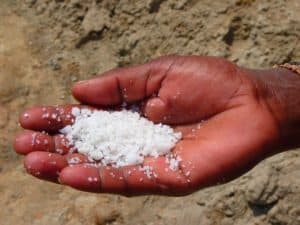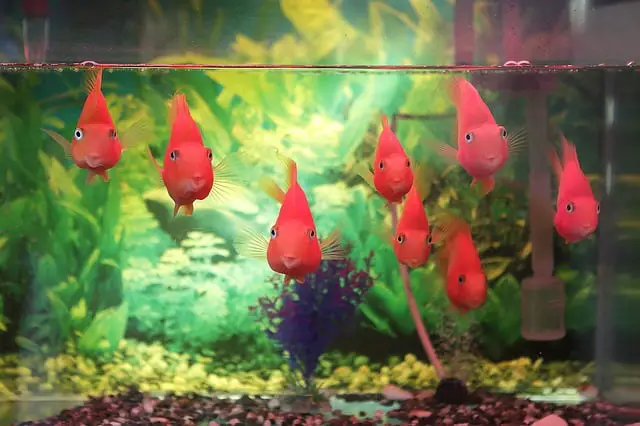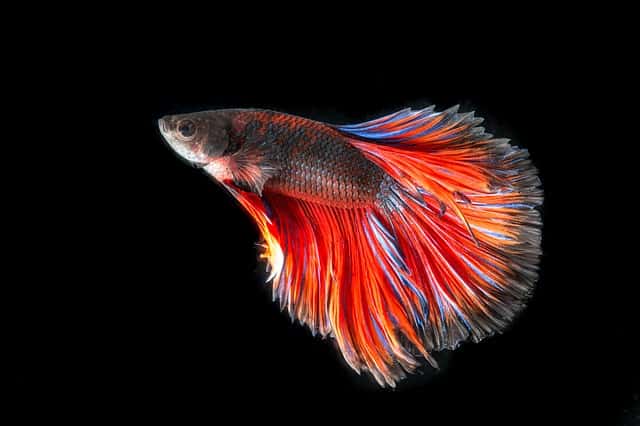When you think of salt, the first thing that usually comes to mind is an additive used to flavour food. You also likely know it’s found naturally in the ocean and is essential to aquatic life. But did you realize that freshwater fish as well as those found in saltwater aquariums can benefit greatly from it! Why add salt to a freshwater tank you may ask? Well, I have the answer for you:
Ordinary table salt (or sodium chloride/NaCl) is helpful in both preventing and treating different types of freshwater fish diseases. When diluted and added to aquarium water, it improves fish health, assists in healing injuries, encourages the formation of slime coating, enhances gill function, guards against parasite infestation, and reduces harmful nitrite/nitrate levels.
Now that you know table salt is good for freshwater fish tanks, let’s explore this topic further and in more detail below. We’ll discuss which type of salt is best, how much to put in, how often to use it and what the many benefits are. We’ll also outline the 4 necessary steps to maintaining your freshwater tank, in addition to adding salt.
So, if you’re ready to learn more about salt and its positive (as well as negative) effects on freshwater fish, then let’s get started!
Can You Put Table Salt in a Freshwater Aquarium?
Salt can be added to a fish tank provided it’s not salt from the ocean. Instead, opt for aquarium, kosher, or canning salt. Table salt that’s non-iodized and additive-free is the best choice. Rock salts or kosher salts are also recommended.
Can You Put Sea Salt in a Freshwater Aquarium?
Sea salt can be used in a freshwater aquarium, though it isn’t recommended. For starters, it’s more expensive than ordinary table salt and it contains trace minerals. These minerals likely won’t harm your freshwater fish, but this type of salt won’t help your fish either.

Is it Good to Add Salt to a Freshwater Aquarium?
As a rule of thumb, adding salt to a freshwater aquarium is generally not recommended. However, its medicinal purposes work wonders on sick fish, provided the species is salt-tolerant. Not only that, it helps balance nitrite levels, which can be dangerous to fish if not properly maintained.
Never add salt to an aquarium with live plants. Even a small amount can kill them and their presence in a freshwater tank is vital to the fish that inhabit it. Instead, you should consider setting up a healing tank where sick fish can be treated on their own.
How Does Salt Affect Freshwater Fish?
Salt not only helps prevent and treat several diseases common to freshwater fish, but it also helps reduce toxicity in the water caused by nitrite. It contains both sodium chloride and chloride (NaCl) ions which are known to balance nitrite levels. It also provides electrolytes that contribute to colouration.
How Often Should You Put Salt in a Freshwater Aquarium?
Salt should be added sparingly to a freshwater aquarium. A safe amount would be 1 tablespoon per 5 gallons of water. Make sure to dilute it first before adding it to the tank. Observe the tank for the next 24 hours and repeat the dosage for up to 4 days, if you don’t notice any improvement. On the 5th day, do a 25 per cent water change and then again once a week for the next month.
It’s very important not to overdo it with the salt in a freshwater tank. Live plants can die from too much salt and even spawning habits of fish can be negatively affected by dehydrating eggs and killing sperm. Bottom-feeders as well as more susceptible to salt and need time to adjust to its presence in the water. Therefore, it’s best to add it slowly in intervals (over several days) instead of all at once.
What Happens if You Put Salt in a Fish Tank?
If you put too much salt in an aquarium, you’ll inevitably kill both the fish and the plants. Even though salt helps reduce nitrite toxicity, it also increases the alkalinity of the water which can result in death by dehydration. It must always be used sparingly and appropriately.
In addition to adding salt, there are 4 other things you should do to maintain a healthy aquarium environment. These include feeding and observing your fish daily, testing the water quality weekly, doing partial (25 per cent) water bi-weekly and changing the filter/cleaning the gravel monthly.
What are the Signs of Too Much Salt in an Aquarium?
When the water parameters are off, fish will often demonstrate behaviours associated with stress. These include hiding for extended periods of time; frequently darting around the tank; franticly swimming about; gasping for air near the surface; rubbing against rocks or gravel; and loss of appetite.
Signs of too much salt in an aquarium include sick and/or dying plants and fish. It can lead to dehydration and an overactive slime coat. A freshwater fish will lose water through osmosis when placed in a tank with too much salt.
Does Salt Raise PH in an Aquarium?
The only type of salt that will raise pH in an aquarium is a marine salt mix. It works to carbonate or increase hardness by binding with the hydrogen atoms in the water. Table salt, on the other hand, simply affects the volume (not the hardness) of the water.
Does Salt in an Aquarium Kill Beneficial Bacteria?
Adding aquarium salt to your freshwater tank will not kill beneficial bacteria. In fact, it’s a cost-effective and natural way to treat and prevent disease. It also improves gill function and promotes the formation of slime coating on the body, which acts as a protective barrier against bacteria and parasite infestation.
Does Salt in an Aquarium Cure Ich?
When added to the water in an aquarium (accompanied by an increase in tank temperature), salt can kill/cure the parasite that causes ‘ich’. Not only that, but it also helps the fish recover its natural slime coating while increasing its resistance to other diseases including gill flukes, fin rot, and mouth fungus.
Does Salt Help Reduce Ammonia in an Aquarium?
Ammonia (NH3) is an invisible chemical that’s toxic to fish. Iodized table salt doesn’t reduce ammonia in an aquarium. In fact, some salt mixes (coupled with tap water) can cause ammonia levels to rise! The best ways to keep ammonia levels down include:
- performing partial water changes regularly
- adding cycled filters
- using concentrated water conditioner
- utilizing ammonia-removing filter media
- not over-stocking the tank
- not overfeeding the fish
- growing beneficial bacteria
- removing decaying vegetation
What Kind of Salt do I add to a Freshwater Aquarium?
The best salt to use in a freshwater aquarium is API Aquarium Salt, available online through Amazon or in-store at your local pet shop. This product is made from evaporated sea salt and improves fish health as well as promotes disease recovery. It can be used when setting up a new aquarium, while changing water in an existing tank, or for treating various fish illnesses.
For over 50 years, API has created a range testing kits, water conditioners, and nutritional food all ‘dedicated to making a better underwater world.’ For the health of your fish and the beauty of your tank, go online and check it out today! Reasonably priced and readily available, it can be delivered right to your front door!
Conclusion
To conclude, traditional table salt is useful in both preventing and treating a variety of freshwater fish diseases. When diluted and added to an aquarium, it improves fish health, aids in disease recovery, promotes the formation of slime coating, increases gill function, negates parasite infestation, and reduces harmful nitrate/nitrite levels.
Hopefully, this article has been of help to you. Thanks for reading and good luck with your freshwater aquarium endeavours!
Related Aquariums at Home Articles
Are Saltwater and Freshwater Filters the Same? (Learn What Filter You Should Use)
Is RO Water Safe for Freshwater Fish
How Often to Change Aquarium Water [Why It’s Important]
What Causes Clamped Fins in Fish?






